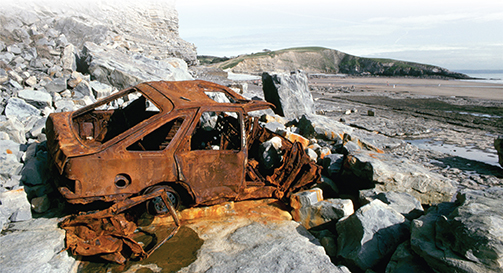Sometimes flammability is not a desirable property. For example, there are laws that regulate the flammability of fabrics. The fabrics used in children's sleepwear must have a low flammability. These fabrics are described as flame-resistant because they are difficult to ignite. If they do ignite, they burn slowly.
Reactivity
The property that describes how readily a substance combines chemically with other substances is reactivity. Nitrogen and oxygen are the main gases in air. Oxygen is a highly reactive element. Nitrogen has an extremely low reactivity.
Oxygen reacts easily with most other elements. Figure 17 shows the rust that forms when oxygen reacts with iron and water. Rust is a brittle, reddish-brown compound. A rusty chain or bolt is more likely to break than a new chain or bolt because rust is weaker than iron. Because iron is highly reactive, yo would not choose iron to make decorative objects, such as jewelry or coins.
Many uses of nitrogen depend on its low reactivity. For example, seawater is often stored in steel tanks located below the lowest deck of a ship. The seawater helps to keep the ship stable in the water. Over time, rust forms in the tanks because iron in the steel reacts with oxygen dissolved in the water. Researchers in Japan have developed a way to reduce the amount of rust produced. They pump nitrogen gas into the tanks, and the nitrogen displaces the dissolved oxygen.

Which element is more reactive—oxygen or nitrogen?
Figure 17 This automobile must have been exposed to air and water for many years.
Drawing Conclusions What evidence is there that parts of the automobile contained iron?






